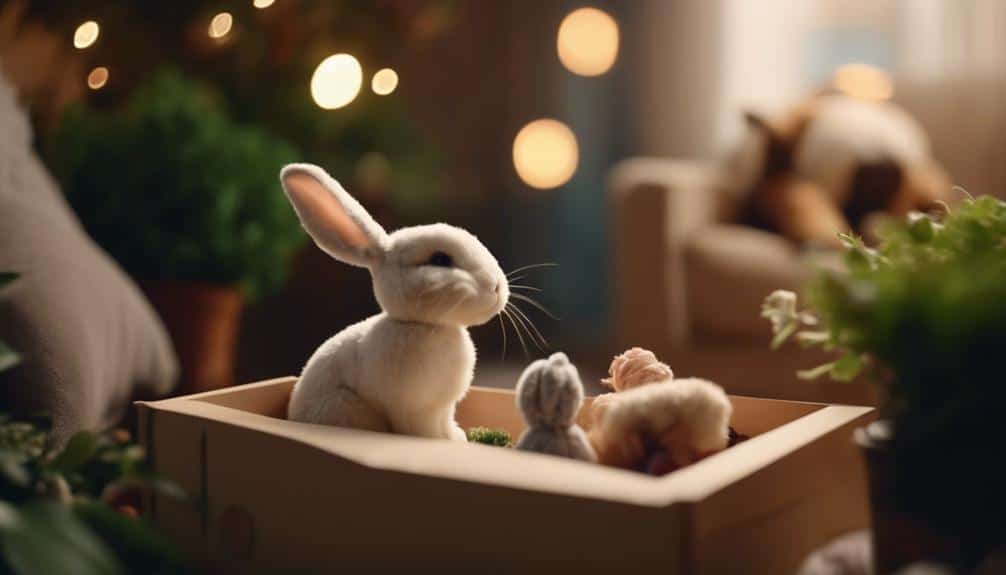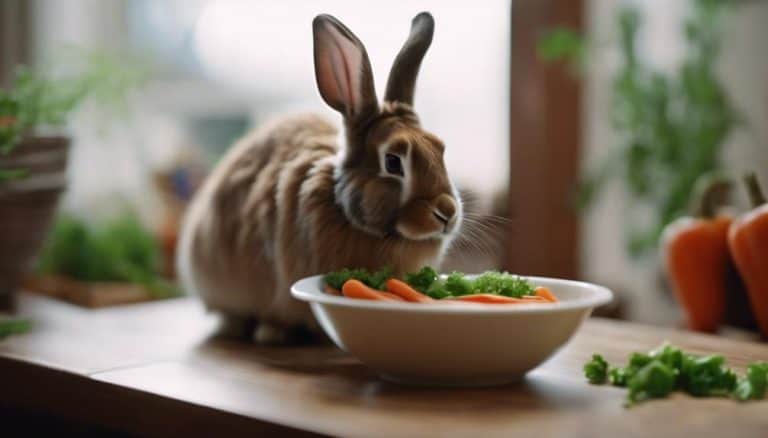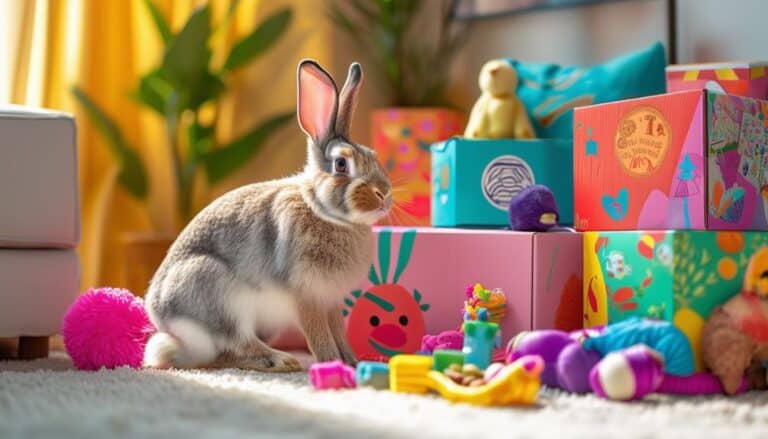How to Comfort Your Pet Rabbit That Doesn't Like Being Held
Comforting a pet rabbit that doesn’t like being held starts with understanding their behavior and creating a safe space where they feel secure. You’ll need to provide cozy retreats, soft bedding, and familiar toys to make them comfortable.
Spend time near your rabbit without picking it up, using treats and gentle petting to build trust gradually. Focus on positive reinforcement and reward calm behavior with treats and verbal praise. Slow, calm movements are key when petting, especially around the forehead and behind the ears. But have you ever wondered how to recognize the subtle signs of stress in your rabbit?
Understanding Rabbit Behavior
To effectively comfort a pet rabbit, you must first understand its natural behavior and body language. Rabbits are prey animals, inherently cautious and sensitive to handling. This natural disposition means your rabbit’s comfort level can be greatly influenced by how it’s approached and handled.
Understanding rabbit behavior involves recognizing the subtle cues they use to communicate discomfort or stress. For instance, a rabbit that thumps its hind legs is signaling alarm, while one that flattens its ears against its back is likely feeling threatened. Rabbits may also exhibit signs of stress, such as rapid breathing or hiding. These behaviors are critical indicators of their emotional state and comfort levels.
Respecting your rabbit’s boundaries is paramount. If your rabbit has had negative past experiences with being held, it may be particularly wary. Building trust takes time. Approach your rabbit slowly and avoid sudden movements that might startle it.
Patience and consistency in your interactions are essential. Positive reinforcement, such as gentle petting or offering treats, can help in gradually making your rabbit more comfortable with being held.
Creating a Safe Space
To create a safe space for your rabbit, provide a quiet and secure area with cozy retreats like tunnels and boxes. Incorporate familiar scents and maintain a calm environment free of loud noises and sudden movements.
Make sure your rabbit has constant access to this space to feel in control and at ease.
Cozy Retreat Setup
Creating a cozy retreat for your rabbit involves providing a quiet, draft-free area with soft bedding, familiar toys, and a covered hideaway to guarantee a sense of security. Start by setting up a comfortable hiding spot where your rabbit can retreat when feeling stressed. Use soft bedding such as fleece blankets or hay mats, which offer a variety of textures for your rabbit to snuggle into.
Position this secure space away from high-traffic areas in your home to minimize disturbances. Ensuring the area is quiet and draft-free will enhance your rabbit’s sense of safety. Including familiar toys can further reduce anxiety and create a comforting environment.
Provide a covered hideaway or tunnel within this space. These structures mimic natural burrows, offering your rabbit a secure space to relax. The hideaway should be easily accessible and large enough for your rabbit to move around comfortably.
| Element | Purpose |
|---|---|
| Comfortable Hiding Spot | Offers a stress-free retreat |
| Soft Bedding | Provides comfort and warmth |
| Covered Hideaway | Secures a burrow-like environment |
Familiar Scents Matter
In addition to providing a cozy retreat, incorporating familiar scents into your rabbit’s living area can greatly enhance their sense of security. Rabbits possess a highly developed sense of smell, which makes them particularly sensitive to familiar aromas. By using your rabbits’ keen olfactory abilities to your advantage, you can greatly reduce their stress and make them feel more comfortable in their surroundings.
Start by placing a piece of your clothing, such as a worn t-shirt, within their living space. Your scent on the fabric will serve as a reassuring presence, helping your rabbit feel more at ease. Items like blankets or towels that carry your scent are also effective in creating a safe and familiar environment.
Research indicates that familiar scents play an important role in calming rabbits by providing a sense of continuity and safety. When your rabbit is comfortable and less anxious, they’re more likely to explore their environment freely and exhibit natural behaviors. This approach not only fosters a stronger bond between you and your pet but also ensures they remain comfortable in their surroundings.
Quiet, Calm Environment
A quiet, calm environment is essential for ensuring your rabbit feels safe and secure. Reducing noise and distractions plays a pivotal role in how your rabbit reacts to its surroundings. By providing a designated safe space with cozy bedding and familiar items, you cater to your rabbit’s personality, promoting a sense of comfort and security.
You’ll want to avoid sudden movements or loud noises near your rabbit’s habitat. This helps maintain a peaceful atmosphere, important for a stress-free environment. Soft, soothing music or white noise can also contribute to a calm setting, helping your rabbit relax.
| Stressor | Mitigation Strategy |
|---|---|
| Loud noises | Use soft music or white noise |
| Sudden movements | Move slowly and predictably |
| Other pets | Keep pets separated from rabbit space |
| Unfamiliar visitors | Limit access to rabbit’s safe area |
| Lack of hiding spots | Provide multiple hiding locations |
Ensuring the area is free of potential stressors like other pets or unfamiliar visitors will further promote tranquility. By meticulously curating this environment, you foster a bond with your rabbit, making it feel secure and understood, enhancing your overall relationship. Adhering to these practices based on evidence will create a sanctuary where your rabbit can thrive.
Building Trust Gradually
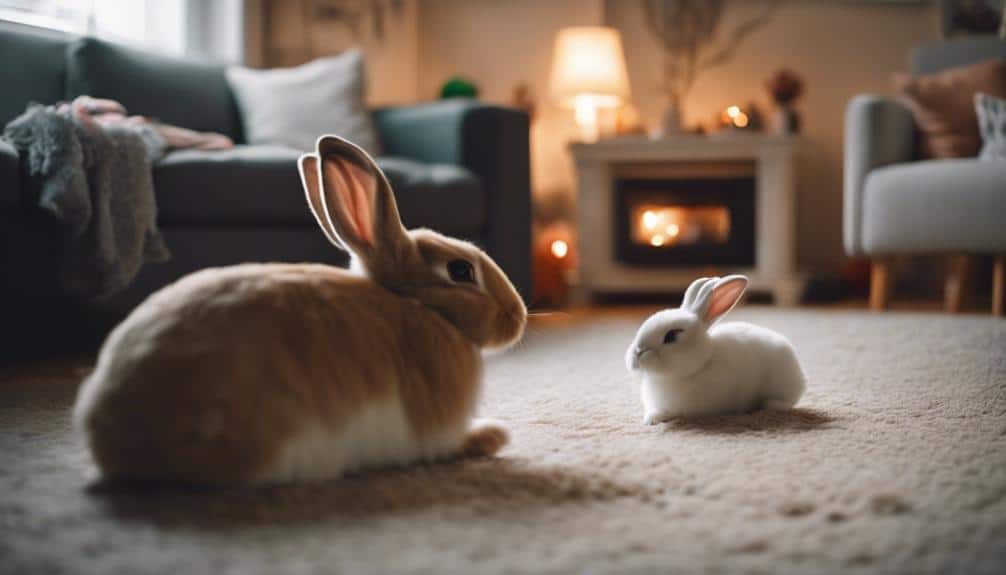
To build trust with your rabbit, start by spending time near them without trying to pick them up. This approach allows your rabbit to become accustomed to your presence without feeling threatened. Building trust requires time and patience, so don’t rush the process. Instead, focus on creating a calm environment where your rabbit feels safe.
Using treats can help foster a positive association with your touch. Gradually introduce gentle petting before attempting to hold your rabbit. Make sure your rabbit is comfortable with each step before progressing.
Here are some steps to help build trust gradually:
- Sit quietly near your rabbit: Let them explore you at their own pace.
- Offer treats: Hold out small treats to encourage your rabbit to come closer.
- Pet gently: Once your rabbit is comfortable taking treats, start with gentle petting.
- Partial weight support: Gradually progress to supporting their weight slightly before attempting to lift them completely.
Always make sure your rabbit feels secure and comfortable. Gradually elevate your rabbit while maintaining a calm demeanor to build trust effectively. By taking these steps, you’ll create a more positive experience for both you and your rabbit.
Positive Reinforcement
Positive reinforcement relies on rewarding your rabbit with treats or praise to encourage calm behavior during handling. By associating being held with something positive like a favorite treat, you can help your rabbit feel more comfortable over time. This technique is evidence-based and focuses on rewarding good behavior to build trust and reduce fear.
| Behavior | Reward Type | Frequency |
|---|---|---|
| Calm during handling | Favorite treat | Every session |
| Approaching you | Verbal praise | Regularly |
| Allowing gentle touch | Small snack | Consistently |
| Staying still | Extra petting | Occasionally |
Using treats strategically during handling sessions can create a bond of trust between you and your rabbit. When your rabbit exhibits calm behavior, immediately reward them with a treat. This positive reinforcement helps them associate handling with a positive experience.
Consistency is key. Regularly rewarding your rabbit for calm behavior will help them build a positive association with being held. Over time, you’ll notice a reduction in their fear and discomfort. This method not only comforts your rabbit but also empowers you to foster a trusting relationship, giving both of you more freedom to interact positively.
Gentle Petting Techniques
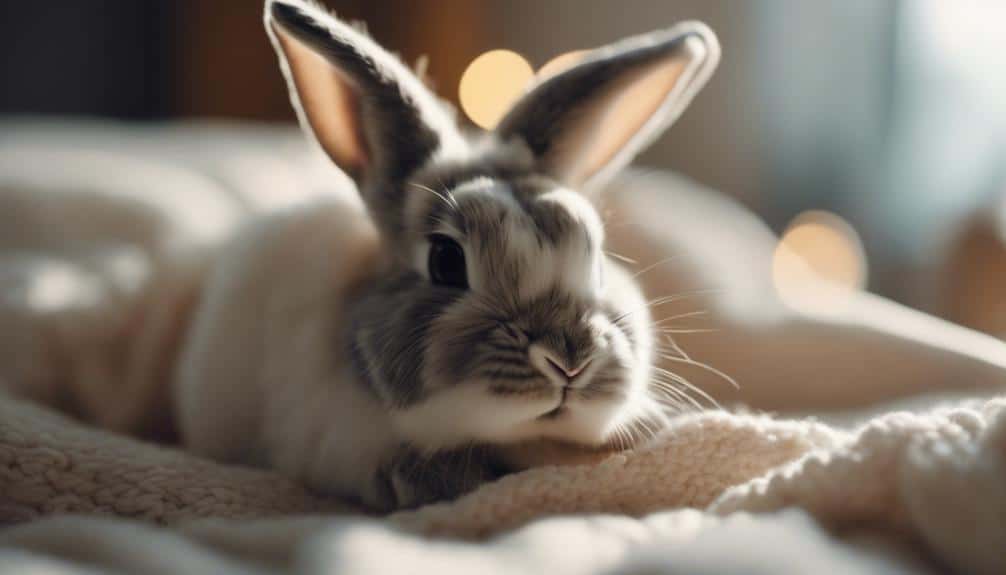
To comfort your rabbit, use slow, calm movements and focus on petting their forehead and behind their ears.
Avoid sensitive areas like the belly and legs to prevent causing discomfort.
Slow, Calm Movements
When approaching your rabbit, use slow, deliberate movements to guarantee you don’t startle them. Given that rabbits are prey animals, sudden or rapid actions can trigger their instinctual fear response, making them more anxious and less receptive to your touch. By adopting slow, calm movements, you can teach your rabbit that you’re not a threat and help them feel more secure in your presence.
Incorporate these techniques to create a soothing environment:
- Approach from the side: Avoid looming over your rabbit, which can seem predatory.
- Gentle strokes: Focus on areas where your rabbit enjoys being petted, such as the forehead or behind the ears.
- Monitor body language: Look for signs of relaxation like purring or a relaxed posture.
- Offer treats: Positive reinforcement can help associate your touch with something pleasurable.
Focus on Ears
Focus on your rabbit’s ears, as they’re particularly sensitive and respond well to gentle, soothing touches, which can greatly enhance their sense of comfort and security.
Begin by slowly extending your hand towards your rabbit’s head, ensuring that your movements are calm and deliberate. Once you’re close enough, gently stroke the base of their ears using light pressure. This type of petting can be incredibly comforting for your rabbit, helping them relax and feel more secure in their environment.
It’s essential to avoid sudden movements or rough handling when petting your rabbit’s ears. Sudden actions can startle your rabbit, causing stress rather than comfort. Instead, maintain a consistent, gentle rhythm, and watch for signs of relaxation, such as a lowered head or closed eyes. These indicators suggest that your rabbit is enjoying the petting and feels at ease.
Additionally, pay close attention to your rabbit’s body language. If they pull away or show signs of discomfort, stop immediately and give them space.
Avoid Sensitive Areas
Petting your rabbit in sensitive areas such as the back and hindquarters can cause discomfort and stress, so it’s important to focus on more well-received regions like the forehead, cheeks, and behind the ears. Employing gentle strokes and light touches in these areas can greatly enhance your rabbit’s comfort and trust.
To make the petting session more enjoyable for your rabbit, consider these expert techniques:
- Forehead and Cheeks: Use gentle strokes, moving slowly and observing your rabbit’s reactions.
- Behind the Ears: This area is often favored by rabbits and can be petted with light, gentle strokes.
- Avoid Sensitive Areas: Steer clear of the back and hindquarters to prevent causing stress.
- Observe Body Language: Watch for signs of relaxation or discomfort to tailor your approach.
Paying attention to your rabbit’s body language is essential. Signs of enjoyment include closing their eyes, relaxing their ears, or gently nudging you for more. Conversely, if they pull away, flick their ears, or thump their feet, it’s a clear signal to stop or adjust your technique.
Recognizing Stress Signals
Identifying stress signals in rabbits, such as thumping, freezing, trembling, or hiding, is vital for ensuring their well-being and comfort. Recognizing stress signals in your rabbit allows you to respond appropriately and create a more calming environment.
Pay close attention to their body language. Thumping can indicate alarm or fear, while freezing often signifies acute stress or an attempt to become less noticeable. Trembling is another clear sign of discomfort, suggesting your rabbit feels threatened or insecure.
Moreover, hiding is a common behavior in stressed rabbits, indicating they feel unsafe. Other subtle signs could include teeth grinding, which can signify pain or extreme anxiety, and avoiding eye contact, suggesting discomfort or submission.
Each rabbit may display stress differently, so it’s important to become familiar with your pet’s specific signals.
Encouraging Voluntary Interaction
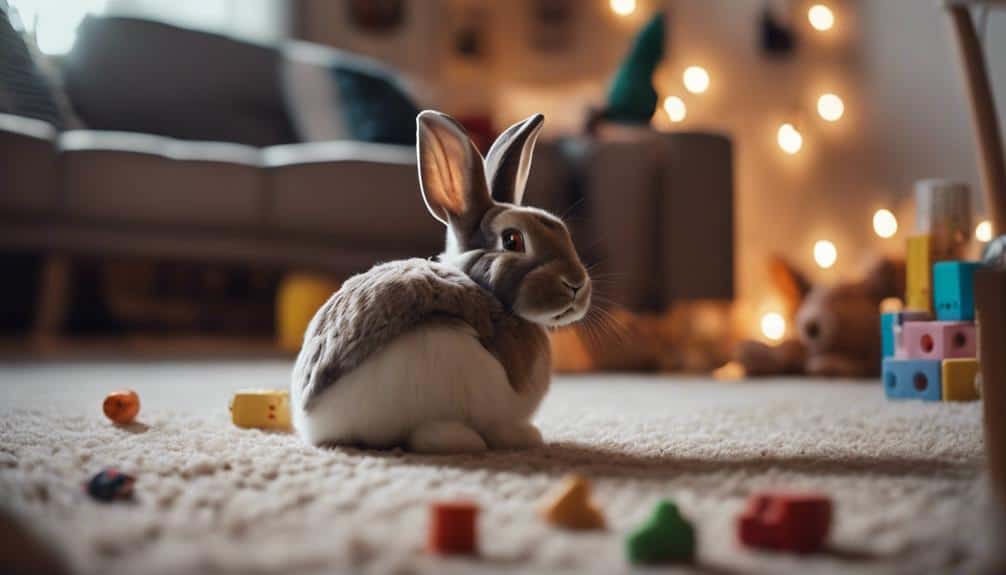
Encouraging voluntary interaction with your rabbit involves allowing them to approach you at their own pace, fostering a sense of trust and security. Start by creating a safe and comfortable environment where your rabbit feels at ease. Avoid putting your hands on them immediately; instead, spend time near their space without attempting to pick them up. This gradual approach helps your rabbit associate your presence with safety.
Using positive reinforcement, such as treats, can motivate your rabbit to come closer. When they do, let them sniff you and investigate without forcing contact. Over time, they’ll begin to trust you and might even let you pet them. It’s important to respect their boundaries and preferences to build a positive relationship.
Here are some tips to encourage voluntary interaction:
- Spend time sitting quietly near your rabbit, allowing them to come to you.
- Offer small treats to reward them for approaching you.
- Use soft, soothing tones when speaking to your rabbit to make them feel safe.
- Gradually put your hands near them without touching, letting them get used to your presence.
Conclusion
To sum up, comforting a rabbit that doesn’t like being held requires patience and understanding. By creating a secure environment and gradually building trust through positive reinforcement, you can foster a sense of safety.
Use gentle petting techniques, focusing on less sensitive areas, and always monitor the rabbit’s body language for stress signals.
Encouraging voluntary interaction will further strengthen your bond, ensuring a calm and comforting experience for your pet.

